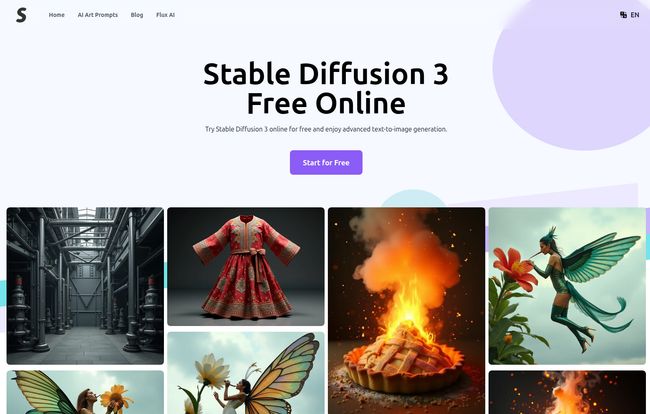Alright, let’s have a chat. If you’re in the digital marketing or content creation space like I am, your inbox and social feeds have probably been a constant storm of "The Next Big Thing in AI." It’s exhausting, right? Every week there’s a new tool that promises to revolutionize how we work. Most of them are a flash in the pan. A few, however, actually stick. And I think Stable Diffusion 3 might just be one of 'em.
I’ve been playing around with AI image generators since they were barely making coherent shapes. It's been a wild ride, from the early days of nightmarish, six-fingered hands to the polished, almost-too-perfect images we see today. So when Stability AI announced their latest model, SD3, the hype was real. I decided to jump into the most direct way to try it: stablediffusion3.net, a platform offering direct access to the model. So, is it just another drop in the AI ocean, or is it the wave we should all be trying to catch?
What's The Big Deal with Stable Diffusion 3 Anyway?
Let's get the technical stuff out of the way. Stable Diffusion 3 is the newest text-to-image model from Stability AI, a company that's been a massive player in the open-source AI community. Unlike some of its walled-garden competitors, the Stable Diffusion family has always had a more accessible, community-driven feel. This new version, however, is a serious step up in raw power.
The platform claims SD3 uses a "diffusion transformer architecture," which is the same sort of engine powering OpenAI's mind-blowing video model, Sora. In layman's terms? It’s supposed to be smarter. It’s supposed to get what you’re asking for on a deeper level. For me, this boils down to three huge improvements that actually matter for creators.
It Finally Understands What You Mean
Prompting an AI can feel like trying to order a super-specific coffee from a barista who only speaks every third word. You ask for a "half-caff, oat milk latte with one pump of vanilla," and you get a black coffee with a lemon wedge. Previous AI models were notorious for this. You'd ask for 'a cinematic shot of an astronaut riding a horse on Mars,' and you'd get a horse floating in space with an astronaut's helmet somewhere in the background. Close, but no cigar.
SD3 has drastically improved its prompt adherence. It’s much better at juggling multiple concepts and complex scene descriptions. It’s less of a gamble and more of a collaboration, which saves a ton of time and frustration.

Visit stablediffusion3.net
Text That You Can Actually Read
Oh man, the text thing. This has been the Achilles' heel of AI image generators for years. Trying to get an AI to write a simple sign that says "OPEN" would result in some alien script that looked like a toddler’s scrawl. It was a running joke. But SD3... well, it’s not perfect, but it's shockingly good. I've successfully generated images with clear, legible text on signs, t-shirts, and book covers. This is a genuine game-changer for creating marketing materials, memes, or any visual that needs typography.
Getting Your Hands Dirty on stablediffusion3.net
So, the tech sounds great. But what's the platform itself like? My first impression of stablediffusion3.net was that it’s clean and to the point. No fluff. Just a gallery of impressive examples and a clear path to start creating. You do have to register, which is a minor hurdle, but pretty standard for any service these days.
Once you’re in, the interface is straightforward. Prompt box, generate button, and some settings. It’s accessible, even if you’re not a seasoned prompt engineer. But the real question is, what can you do for free?
A Free Taste of The Future
The platform offers a free plan, but let's be crystal clear: this is a trial. You get 10 free generations to use within your first 7 days. That's it. It's enough to kick the tires, see the quality for yourself, and decide if it's a tool you want to invest in. I actually appreciate this approach. Instead of a heavily throttled, ad-supported free-for-life model, they give you a real taste of the premium experience. After that, you've got to decide if you're willing to pay to play.
Breaking Down the Pricing: Is It Worth Your Money?
And that brings us to the most important question for any freelancer, agency owner, or hobbyist: what's this going to cost? The pricing is tiered, and frankly, it seems pretty reasonable compared to some of teh competition.
| Plan | Cost (Billed Yearly) | Key Features | Best For |
|---|---|---|---|
| Free | $0 | 10 generations (first 7 days), public images, no commercial license. | Curious testers. |
| Pro | $5/month | 1000 fast generations/month, private images, commercial license. | Freelancers, content creators, small businesses. |
| Max | $10/month | 3000 fast generations/month, private images, commercial license. | Agencies, power users, high-volume creators. |
For my money, the Pro plan is the sweet spot. At five bucks a month, you get 1,000 generations, which is more than enough for most monthly content needs. But the two most critical features here are the commercial license and private images. Being able to use what you create for your business without worry and keeping your experiments confidential is non-negotiable for any professional use case.
The Max plan is for the true power users. If you're running an agency or your entire workflow is built around AI image generation, then 3,000 generations for $10 is an absolute steal.
How Does It Stack Up Against the Titans?
It's impossible to talk about SD3 without mentioning Midjourney. For a long time, Midjourney has been the king of hyper-stylized, beautiful imagery. It has a distinct artistic flair. I've always felt, however, that Midjourney does what it wants, and you're just along for the ride. It's an artist with a strong opinion.
Stable Diffusion 3, on the other hand, feels more like a highly skilled, obedient assistant. It listens more closely to the prompt. Its ability to handle complex scenes and, most importantly, legible text gives it a practical edge for many commercial applications where specificity is more important than pure artistic flourish. Its open-source roots also mean there's a wider ecosystem developing around it, which is something to keep an eye on.
A Few Things to Keep in Mind
No tool is perfect. The biggest "gotcha" here is the limited free trial. Don't go in expecting a lifetime of free images. This is a premium product with a premium-gated experience. Also, for the super tech-savvy folks, self-hosting the model for ultimate control requires a separate Stability AI Membership, so this platform is more of a SaaS (Software as a Service) entry point, not a download hub. These aren't dealbreakers, just facts to be aware of.
Final Thoughts from an Old SEO Hand
So, what’s the verdict? I'm genuinely impressed. Stable Diffusion 3 is a significant leap forward, particularly in the areas that have been most frustrating for creators: prompt accuracy and text generation. The platform at stablediffusion3.net provides a clean, no-nonsense way to access this power, with a pricing structure that makes sense for professionals.
Is it going to replace human artists and designers? No. But is it an incredibly powerful tool that can help you generate ideas, create stunning visuals for blog posts, social media, and ads, and speed up your workflow? Absolutely. It’s worth the 10 free credits to see for yourself. The world of AI is moving at a breakneck pace, and for now, Stable Diffusion 3 is definitely one of the front-runners.
Frequently Asked Questions
What exactly is Stable Diffusion 3?
Stable Diffusion 3 is the latest and most advanced text-to-image AI model from Stability AI. It's designed to create high-quality images from text descriptions, with major improvements in understanding complex prompts and rendering legible text within the images.
Can I really use Stable Diffusion 3 for free?
Yes, but with limitations. The platform stablediffusion3.net offers a free trial that includes 10 image generations to be used within your first seven days after signing up. After that, you'll need to subscribe to a paid plan to continue generating images.
Are the images I create private?
On the free plan, your images are public. To create private images that are only visible to you, you need to be on the Pro or Max paid plans. This is a crucial feature for any commercial or confidential work.
Can I use the images for my business?
To use the images for commercial purposes (like on your blog, in ads, or on products), you must subscribe to the Pro or Max plan, both of which include a commercial license. The free plan does not grant you these rights.
How is SD3 different from other AI image generators?
Its main advantages are its superior ability to follow complex prompts with multiple subjects and its groundbreaking capability to render clear, accurate text within images. While others might excel at a specific artistic style, SD3 is a versatile workhorse for practical and creative tasks.
What happens if I run out of generations on a paid plan?
Your generation credits reset each month with your subscription renewal. The plans offer a substantial number of credits (1000 for Pro, 3000 for Max) which are typically more than enough for most users' monthly needs.
Conclusion
In a field crowded with hype, Stable Diffusion 3 feels like a tangible step forward. It's a tool that solves real problems for creators, especially with its improved prompt comprehension and text capabilities. While the free access is just a taster, the paid plans are competitively priced and packed with the features professionals actually need. It's earned a spot in my digital toolbox, and I recommend giving it a spin to see if it earns a spot in yours.
Reference and Sources
- Main Platform: stablediffusion3.net
- Pricing Information: stablediffusion3.net/pricing



